Before You Begin
Before starting the repair gutter drain pipe, assess the extent of the damage and identify the specific areas that need attention. Ensure that you have a clear understanding of the drainage system layout to streamline the repair process. Additionally, check local regulations and obtain any necessary permits before initiating repairs.
Safety Considerations
Prioritize safety during the repair of your underground gutter drainage system. Wear appropriate personal protective equipment (PPE), such as gloves and safety glasses, to shield yourself from potential hazards. Exercise caution when working in confined spaces and be aware of the presence of any electrical lines or utility connections. If the repair involves excavation, take precautions to prevent accidents and collapses.
Equipment / Tools
Gather the necessary tools and equipment before starting the repair work. Common tools for underground gutter drainage repair may include a shovel, a pickaxe, a pipe cutter, and a wrench. Depending on the specific issues, you might also need a pipe inspection camera to identify blockages or damage within the pipes. Ensure that all tools are in good working condition before use.
Materials
Prepare the required materials for the repair project. This may include replacement pipes, connectors, couplings, and waterproof sealants. If there are any damaged or corroded sections, consider replacing them with durable materials to prevent future issues. Verify that the materials are compatible with the existing drainage system to ensure a proper and long-lasting repair.
4 Steps to Repairing Your Underground Gutter Drainage System
Step 1: Check the downspouts, underground clogs, and outflow openings
Before initiating any repair work:
- Conduct a thorough inspection of your underground gutter drainage system.
- Start by examining the downspouts for any visible damage, such as cracks or disconnections.
- Ensure that the downspouts are securely attached to the gutters and are directing water away from the foundation.
Next, check for underground clogs. Observe the flow of water during rain or use a hose to simulate rainfall. Look for any areas where water is pooling or not flowing freely. This may indicate a blockage in the underground pipes.
Inspect the outflow openings, such as the pop-up emitters or drainage grates, to ensure they are clear of debris and functioning properly. Clear any obstructions that may impede the water flow from the underground drainage system.
Step 2 – Repairing Visible Ends
Once you’ve identified the issues with the downspouts, underground clogs, or outflow openings, proceed to repair any visible ends that require attention.
- Downspout Repair: If there are cracks or disconnections in the downspouts, use appropriate sealants or connectors to mend the damaged sections. Ensure a secure and watertight connection between the downspout and the gutter.
- Outflow Opening Maintenance: Clean out any debris or dirt from the outflow openings. If the pop-up emitters or drainage grates are damaged, replace them with new ones. Ensure that the outflow openings are free from obstructions to facilitate proper water discharge.
Step 3 – Locating Your Gutter Drainage System
Before patching up visible ends, accurately locate the underground gutter drainage system. Use a map or any existing documentation to identify the path of the drainage pipes. If no such information is available, you may need to employ a pipe locator or hire a professional service to help locate the pipes.
Step 4: Patch up the visible ends of the gutter drain pipe
After locating the underground gutter drainage system and addressing issues with downspouts and outflow openings, focus on patching up the visible ends of the gutter drain pipe.
- Inspect for Damage: Examine the exposed ends of the gutter drain pipe for cracks, leaks, or other visible damage.
- Use Sealants or Repair Sleeves: Apply waterproof sealants or utilize repair sleeves to mend any visible damage. Ensure that the repairs are secure and effectively seal any openings.
- Reconnect Sections: If there are disconnected sections, use appropriate connectors to reattach and secure the gutter drain pipe. Ensure a tight fit to prevent future leaks.
- Test the Repairs: After completing the repairs, test the system by running water through the gutters and observing the flow through the underground drainage system. Check for any signs of leakage or issues with the repaired sections.
Why do gutters leak?
Blocked gutters
Blocked gutters are a common cause of leaks in gutter systems. When leaves, twigs, dirt, and other debris accumulate in the gutters, they create obstructions that hinder the smooth flow of water. As the debris builds up, it can lead to water overflow, causing the gutters to leak. Additionally, the weight of the debris may put a strain on the gutter system, potentially causing it to pull away from the structure or develop cracks.
Prevention and Solution: Regular gutter maintenance, including cleaning and removing debris, is essential to prevent blockages. Install gutter guards or screens to minimize the amount of debris entering the gutters, reducing the frequency of cleanings.
Incorrectly installed gutters
Improper installation of gutters can result in various issues, including leaks. If gutters are not installed with the correct pitch or slope, water may pool in certain areas rather than flow toward the downspouts. This standing water can contribute to rusting and corrosion, ultimately leading to leaks. Poorly aligned or sagging gutters may also cause water to overflow, increasing the risk of leaks.
Prevention and Solution:
- Ensure that gutters are installed by professionals or individuals with experience in proper gutter installation.
- Confirm that gutters have the correct pitch for water to flow efficiently toward the downspouts.
- Periodically inspect gutters for signs of sagging or misalignment and address any issues promptly.
Joint issues
Gutter systems consist of sections that are joined together, and the joints are potential areas for leaks. Over time, the joints may weaken due to weathering, expansion, and contraction or insufficient sealing. Leaks at joints can occur when the connections between gutter sections become compromised, allowing water to escape.
Prevention and Solution:
- Regularly inspect gutter joints for signs of wear or damage.
- Apply a high-quality gutter sealant to reinforce and waterproof the joints.
- Replace damaged or deteriorating sections of the gutter if necessary.
Holes in gutters
Holes in gutters can result from various factors, including rust, corrosion, impacts from falling branches, or even poor manufacturing. These holes create direct points of water leakage, causing water to escape from the gutter system.
Prevention and Solution:
- Inspect gutters for signs of rust or corrosion, especially in older systems.
- Replace any sections with visible holes.
- Consider using gutter patches or sealants to mend small holes.
- Regularly trim tree branches that could potentially fall onto the roof and damage the gutters.
The issues associated with gutters leaking
Gutter leaks pose a myriad of issues that can have significant implications for the structural integrity and overall well-being of a property. One of the primary concerns associated with gutter leaks is water damage to the foundation and exterior of the building. When gutters fail to channel rainwater away from the structure due to leaks effectively, water can accumulate around the foundation, leading to erosion, cracks, and potential structural instability.
Additionally, leaks contribute to the deterioration of the gutter system itself, promoting rust, corrosion, and the development of weak points. As water escapes through leaks, it can create unsightly stains on the exterior walls and contribute to the growth of mold and mildew. The interior of the property is not immune to the consequences of gutter leaks either, as water infiltration can damage ceilings, walls, and insulation, leading to the need for costly repairs and posing health risks.
Furthermore, leaks in gutters can compromise landscaping by causing soil erosion and damage to plants and flowers. In colder climates, unresolved leaks can contribute to ice dams, putting additional stress on the roof and potentially leading to roof damage. Therefore, the issues associated with gutter leaks extend beyond mere inconvenience, encompassing a range of structural, aesthetic, and environmental concerns that necessitate proactive maintenance and timely repairs to safeguard the overall integrity of the property.
The Difference Between a Heavy Contractor and Other Types of Contractors
The distinction between a heavy contractor and other types of contractors lies primarily in the scale and nature of the construction projects they undertake. Heavy contractors specialize in large-scale infrastructure projects that involve substantial earthmoving, excavation, and heavy machinery. These projects typically include the construction of highways, bridges, dams, airports, and other major civil engineering endeavors.
Heavy contractors possess specialized expertise in managing complex logistics, intricate engineering requirements, and compliance with stringent safety and environmental regulations. In contrast, other types of contractors, such as general contractors or residential contractors, are often involved in smaller-scale projects like residential construction, commercial building renovations, or interior improvements. Heavy contractors typically work with massive equipment, such as bulldozers, cranes, and excavators, and their projects demand a high level of precision and technical know-how.
Additionally, heavy contractors often engage in bid processes for public works projects and must navigate the intricacies of government contracts. The differentiation is not only in the size of the projects but also in the specialized skill set, equipment, and regulatory knowledge required to execute heavy construction projects successfully. While general contractors may oversee a broad range of construction tasks, heavy contractors specialize in the monumental and intricate challenges posed by large-scale infrastructure development.
What Are the Best Alternatives to Gutters
While traditional gutters are effective in channeling rainwater away from a building’s foundation, several alternative systems offer unique advantages. One popular alternative is the use of rain chains, which replace downspouts with aesthetically pleasing chains or decorative cups. Rain chains guide water downward, creating a visually appealing waterfall effect. Another innovative option is the installation of French drains or gravel trenches strategically placed around the foundation to redirect water away from the building. This method promotes natural drainage and minimizes the need for above-ground gutter systems.
Additionally, roof design modifications, such as creating a sloped roof with overhangs or eaves, can help direct rainwater away from the building without the need for traditional gutters. Green roofs, featuring vegetation that absorbs and filters rainwater, also offer an environmentally friendly alternative. However, it’s essential to note that these alternatives may not be suitable for every climate or architectural design, and their effectiveness depends on factors such as local rainfall patterns and landscaping. Ultimately, the best alternative to traditional gutters depends on the specific requirements of the property, considering both functionality and aesthetic preferences.
How Your Roof and Gutters Can Be Affected by Wind Damage
Wind damage can have a profound impact on both roofs and gutters, posing a range of threats to the structural integrity of a property. The forceful winds associated with storms can lift and displace roofing materials, such as shingles or tiles, exposing the underlying structure to the elements. This not only compromises the roof’s ability to provide effective shelter but also increases the risk of water infiltration, potentially leading to interior damage and mold growth. Moreover, strong winds can create uplift forces, especially at the edges of roofs, causing shingles or other roofing materials to peel away.
In addition to direct damage to the roof, wind can wreak havoc on gutters. High winds can loosen, bend, or even completely detach gutter sections, hindering their ability to channel rainwater away from the building. Debris carried by the wind, such as branches or even airborne projectiles, can impact gutters, causing dents, cracks, or misalignments. When gutters are compromised, water can overflow, leading to water damage to the building’s exterior, foundation, and landscaping. In severe cases, the combined impact of wind damage on roofs and gutters can result in the need for extensive repairs, emphasizing the importance of proactive maintenance, periodic inspections, and timely repairs to fortify these critical components of a building against the forces of nature.
When to Call a Professional
Calling a professional for various home-related issues is crucial when certain situations exceed your expertise or require specialized skills and tools. Here are common scenarios indicating when it’s time to seek the services of a professional:
- Structural Issues: If you notice structural problems in your home, such as cracks in the foundation, walls, or roof, it’s essential to consult a structural engineer or contractor. They can assess the severity of the issue and recommend appropriate solutions.
- Electrical Problems: Electrical issues, such as frequent power outages, sparking outlets, or tripped circuit breakers, should be addressed by a licensed electrician. Electrical work can be hazardous, and attempting to fix complex problems without proper knowledge can lead to safety risks.
- Plumbing Emergencies: Water leaks, burst pipes, and sewage backups are emergencies that require immediate attention from a professional plumber. Water damage can escalate rapidly, and plumbers have the expertise and tools to diagnose and fix plumbing issues efficiently.
- HVAC System Malfunctions: If your heating, ventilation, or air conditioning (HVAC) system is not functioning correctly, especially in extreme weather conditions, it’s advisable to call an HVAC technician. They can diagnose issues, perform necessary repairs, and ensure your system operates efficiently.
- Roofing Problems: Leaks, missing shingles, or extensive damage to your roof should be handled by a professional roofing contractor. Climbing onto the roof without proper safety measures can be dangerous, and professionals have the expertise to identify and address roofing issues effectively.
- Pest Infestations: If your home is affected by pests, such as termites, rodents, or bedbugs, it’s best to hire a pest control professional. They can assess the extent of the infestation, implement appropriate treatments, and provide guidance on preventive measures.
- Mold Remediation: Extensive mold growth requires the expertise of professionals in mold remediation. They can assess the source of the mold, safely remove it, and implement measures to prevent its recurrence.
- Major Renovations or Remodeling: For significant home renovations or remodeling projects, hiring a contractor or construction professional is advisable. They can manage the project, ensure compliance with building codes, and deliver high-quality artistry.
- Appliance Repairs: If major household appliances, such as refrigerators, washing machines, or ovens, malfunction, calling a certified appliance repair technician is recommended. Attempting DIY repairs on complex appliances can lead to further damage.
- Landscaping and Tree Services: For tasks like tree removal, large-scale landscaping, or dealing with dangerous tree limbs, it’s safer to hire a professional tree service or landscaper with the necessary equipment and expertise.
In general, if a task requires specialized knowledge, poses safety risks, or involves intricate systems, seeking the assistance of a qualified professional is the prudent choice to ensure the job is done correctly and safely.
How Often to Replace Gutters
The frequency with which you should replace gutters depends on various factors, including the material of the gutters, local weather conditions, and the level of maintenance they receive. Here are some general guidelines to help you determine when to consider gutter replacement:
- Material Lifespan:
- Aluminum Gutters: Typically last 20-25 years.
- Copper Gutters: Can last 50+ years but are more expensive.
- Vinyl Gutters Have a lifespan of about 20 years.
- Galvanized Steel Gutters: Last around 20 years but may rust over time.
- Stainless Steel Gutters: Durable and can last 25-30 years or more.
- Local Weather Conditions:
- Areas with frequent heavy rainfall, snow, or extreme temperature fluctuations may experience faster gutter wear. High humidity and exposure to salt air in coastal regions can also impact the longevity of gutters.
- Maintenance:
- Regular cleaning and maintenance can extend the life of gutters. Debris buildup, such as leaves and twigs, can lead to clogs and water damage. If gutters are well-maintained, they are less likely to deteriorate prematurely.
- Signs of Damage:
- Inspect your gutters regularly for signs of damage. Look for rust, corrosion, sagging, or visible cracks. If you notice significant wear or damage, it may be time to consider replacement.
- Frequent Repairs:
- Find yourself constantly repairing the same sections of your gutters. It may be more cost-effective to invest in new gutters. Continuous repairs can be a sign that the system is reaching the end of its useful life.
- Home Renovations:
- If you are planning major renovations or roofing work, it might be a good time to assess the condition of your gutters. If they are older or in poor condition, replacing them during larger renovation projects can be efficient.
- Changes in Homeownership:
- When buying a new home, it’s essential to determine the age and condition of the existing gutters if the gutters are old or damaged, factor in the potential need for replacement in your overall home maintenance plan.
- Upgrading for Efficiency:
- Suppose your current gutters are not effectively managing water runoff. In that case, you might consider upgrading to a more efficient system, such as larger gutters or those with built-in leaf guards.






